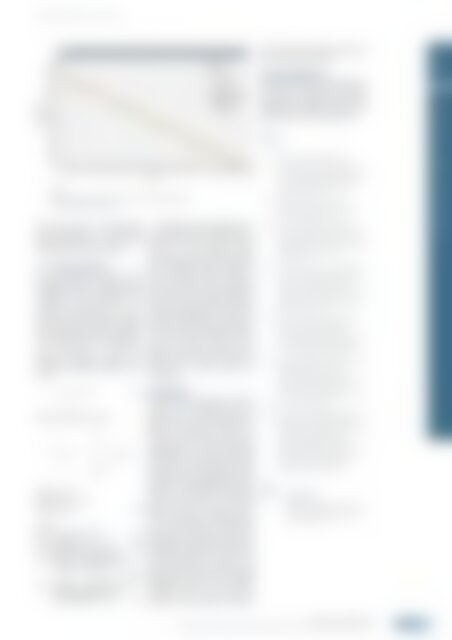atw 2018-04v6
Create successful ePaper yourself
Turn your PDF publications into a flip-book with our unique Google optimized e-Paper software.
<strong>atw</strong> Vol. 63 (<strong>2018</strong>) | Issue 4 ı April<br />
| | Fig. 7.<br />
Pressure along two selected axial lines in the wire-wrapped rod bundle.<br />
The inset specifies location of lines.<br />
drop using data at corresponding<br />
wire-wrap positions, i.e. from axial<br />
positions 0.065 m to 1.268 m. The<br />
mean pressure drop is 946 Pa/m.<br />
2.3 Model validation<br />
In this subsection, results of our<br />
numerical study are compared to the<br />
simplified Cheng and Todreas [1986]<br />
correlation. The correlation was<br />
recently recommended in (1) to<br />
predict pressure drop (Δp) in bundles<br />
with an accuracy of ±20 %. It applies<br />
for a wide range of Reynolds- numbers.<br />
The friction factor (f) is defined in<br />
eq. 1, where d h,bdl , L, and u b<br />
2<br />
are<br />
hydraulic diameter, length, and<br />
average axial bundle velocity, respectively.<br />
(1)<br />
The correlation for f reads<br />
for Re < Re L<br />
for Re L ≤ Re ≤ Re T<br />
for Re > Re T (2)<br />
where<br />
Re L = 300 x 10 1.7(P/D−1.0) (3)<br />
Re T = 10,000 x 10 0.7(P/D−1.0) (4)<br />
ψ = log(Re/Re L ) / log(Re T /Re L ) (5)<br />
C fL = (-974.6 + 1612.0(P/D) −<br />
598.5(P/D) 2 )(H/D) .06-0.085(P/D)<br />
(6)<br />
C fT = (0.8063 − 0.9022(log(H/D)) +<br />
0.3526(log(H/D)) 2 ) ×<br />
(P/D) 9.7 (H/D) 1.78-2.0(P/D) (7)<br />
We compare the nominal flow case<br />
of 3.580 kg/s which corresponds to a<br />
velocity of 0.2 m/s and Re is 8910,<br />
which is in the transient region.<br />
According to eqns (3) and (4), Re L and<br />
Re T are 902 and 15735, respectively.<br />
The calculated friction factor f<br />
equates to 0.0557. This corresponds<br />
to a pressure drop in the bundle of<br />
1407.2 Pa. The predicted pressure<br />
drop resulting from the CFD study is<br />
1,138 Pa. The difference is near 19 %,<br />
which lays within the accuracy limits.<br />
In future thermos-hydraulic simulations,<br />
the current model can be<br />
applied. For posttest analysis, additional<br />
sensitive studies might be<br />
necessary to further reduce the<br />
uncertainty.<br />
Conclusions<br />
The flow in the gap between neighbouring<br />
fuel assemblies plays an<br />
important role in transients between<br />
forced and natural convection. At<br />
KALLA an experiment on the interwrapper<br />
flow is currently setup and<br />
accompanied by pre-test numerical<br />
CFD studies. These proof that both<br />
the flow in the gap region and the<br />
fuel bundle are not influenced by the<br />
upstream flow-conditioning region.<br />
Moreover, development length are<br />
much shorter than the unheated<br />
length of the test section, so that<br />
the thermal field is uninfluenced by<br />
flow non-uniformities. Preliminary<br />
comparison of pressure losses computed<br />
by CFD and correlation provide<br />
reasonable agreement for both the<br />
gap and bundle. The result of our<br />
study enters pre-test studies of the<br />
thermal field within the EU-H2020<br />
SESAME project. There complete<br />
simulation of the test section consisting<br />
of three bundles connected<br />
by the gap region including conjugate<br />
heat transfer is performed.<br />
Acknowledgement<br />
This project has received funding from<br />
the Euratom research and training<br />
programme 2014-<strong>2018</strong> under grant<br />
agreement No 654935 and from the<br />
AREVA Nuclear Professional School.<br />
References:<br />
[1] Chen, S.; Todreas, N.; Nguyan, N.<br />
(2014). Evaluation of existing correlations<br />
for the prediction of pressure drop<br />
in wire-wrapped hexagonal array pin<br />
bundles. Nuclear Engineering and<br />
Design 267, pp. 109 – 131<br />
[2] Rehme, K. (1973). Pressure drop<br />
correla tions for fuel element spacers.<br />
Nuclear Technology 17, 15–23.<br />
[3] Baxi, C.B., Dalle Donne, M., (1981).<br />
Helium cooled systems, the gas cooled<br />
fast breeder reactor. In: Fenech, H. (Ed.),<br />
Heat Transfer and Fluid Flow in Nuclear<br />
Systems. Pergamon Press Inc.,<br />
pp. 410–462.<br />
[4] Cheng, S.-K.; Todreas, N. (1986). Hydrodynamic<br />
models and correlations for<br />
bare and wire-wrapped hexagonal rod<br />
bundles - Bundle friction factors,<br />
subchannel friction factors and mixing<br />
parameters. Nuclear Engineering and<br />
Design 92 (2), 227 – 251.<br />
[5] Kirillov, P.L., Bobkov, V.P., Zhukov, A.V.,<br />
Yuriev, Y.S., (2010). Handbook on<br />
Thermo hydraulic Calculations in<br />
Nuclear Engineering. Thermohydraulic<br />
Processes in Nuclear Power Facilities,<br />
vol. 1. Energoatomizdat, Moscow.<br />
[6] Kamide, H.; Hayashi, K.; Toda, S. (1998).<br />
An experimental study of intersubassembly<br />
heat transfer during<br />
natural circulation decay heat removal<br />
in fast breeder reactors. Nuclear<br />
Engineering and Design 183, 97 – 106.<br />
[7] http://sesame-h2020.eu/<br />
[8] Pacio, J, et. al. (2016), Deliverable 2.10 –<br />
KALLA Inter- wrapper flow setup for<br />
SESAME (thermal hydraulics Simulations<br />
and Experiments for the Safety<br />
Assessment of MEtal cooled reactors)<br />
project, activity: NFRP-01-2014<br />
Improved safety design and operation<br />
of fission reactors, H2020 Grant<br />
Agreement Number: 654935.<br />
Authors<br />
Abdalla Batta<br />
Andreas G. Class<br />
AREVA Nuclear Professional School<br />
Karlsruhe Institute of Technology<br />
Karlsruhe, Germany<br />
OPERATION AND NEW BUILD 229<br />
Operation and New Build<br />
Numerical Analysis of MYRRHA Inter- wrapper Flow Experiment at KALLA ı Abdalla Batta and Andreas G. Class

















